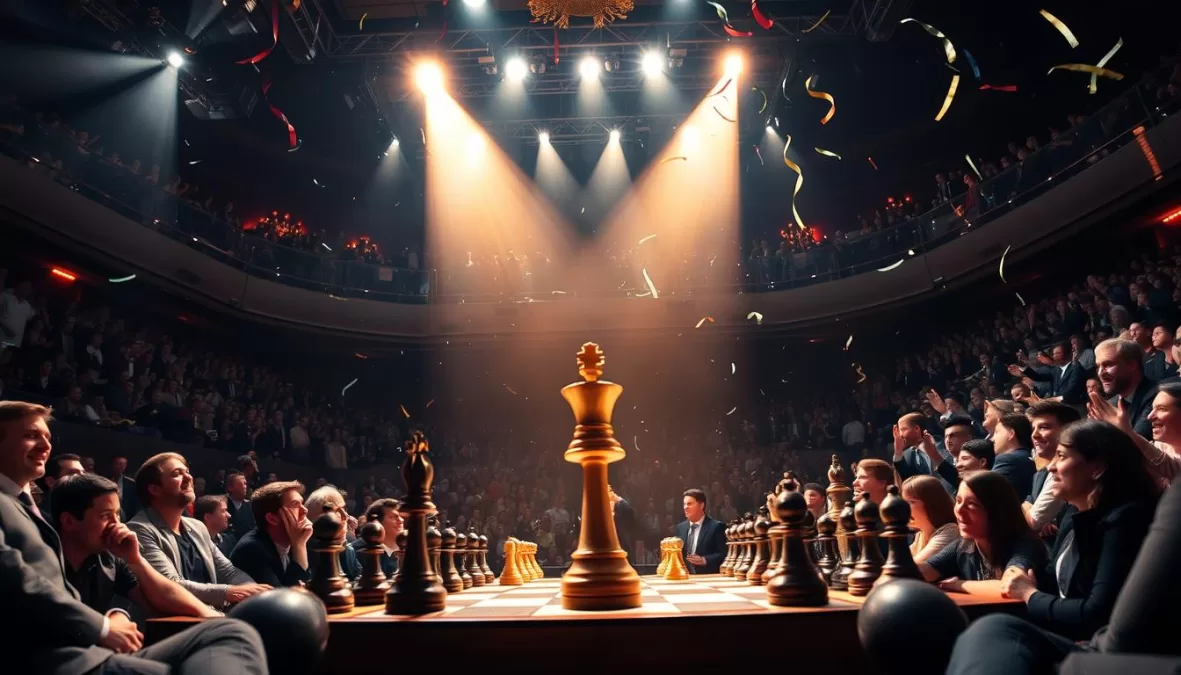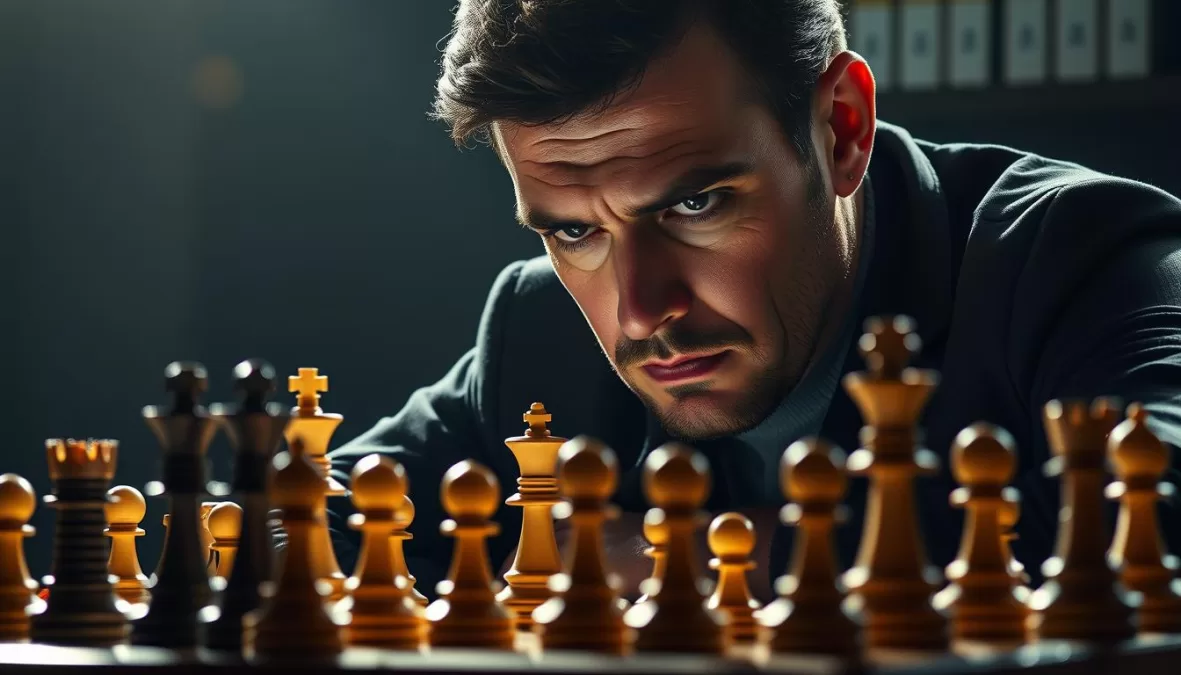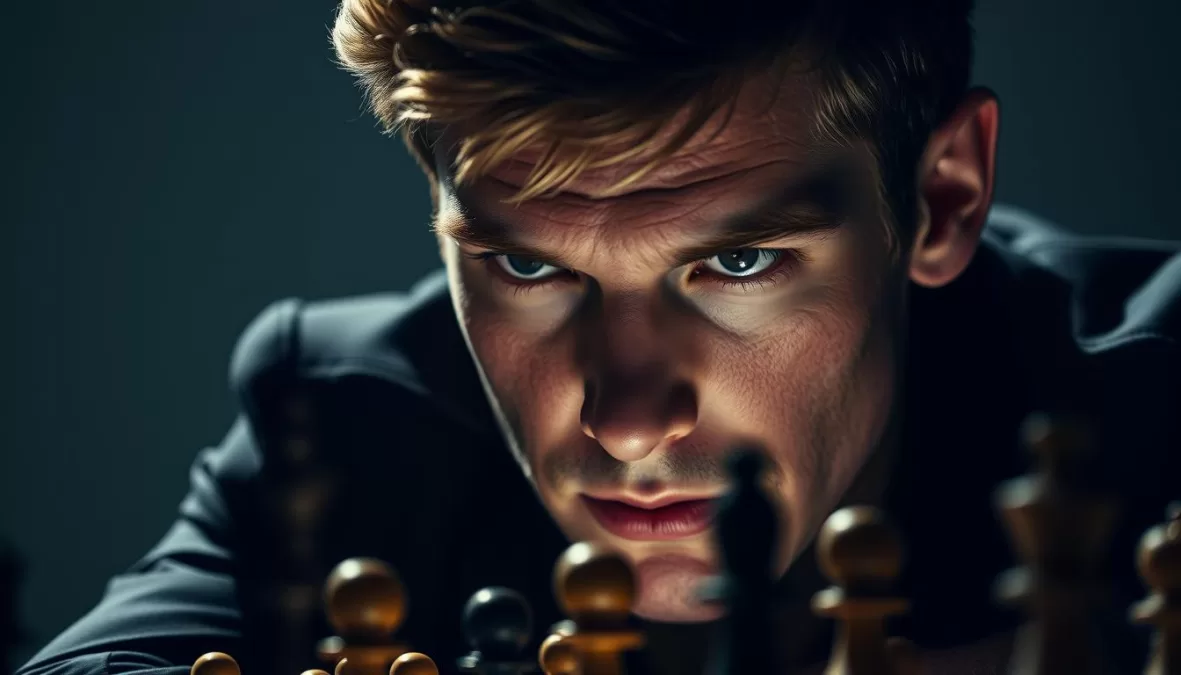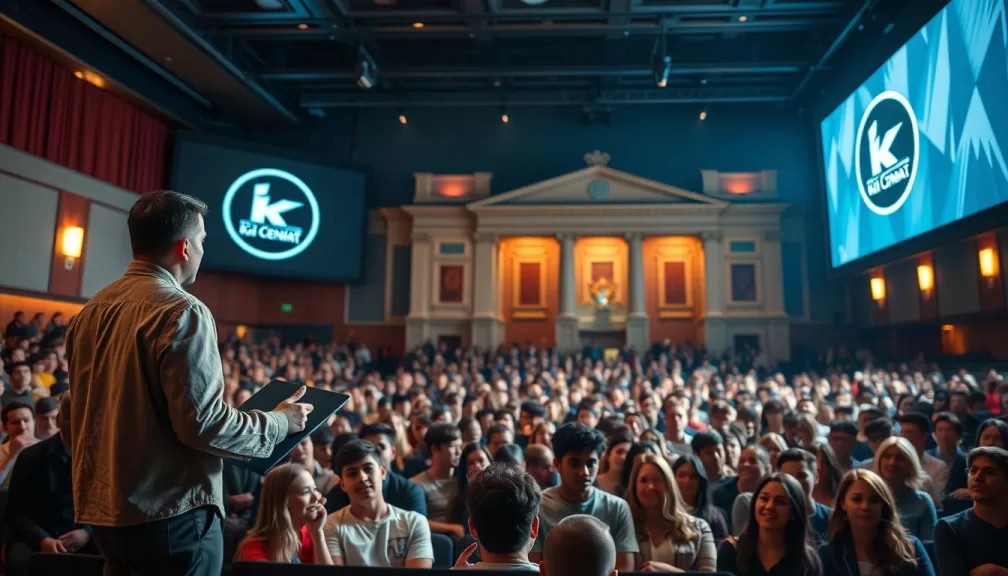Few players have dominated the world of chess like Magnus Carlsen. With five world chess championship titles, he stands as the undisputed king of modern tournament play. His record-breaking peak rating of 2882 and an astonishing 125-game unbeaten streak showcase his unrivaled skill.
Carlsen’s influence extends beyond classical games. He has mastered rapid and blitz formats, making him the only player to hold all three world titles simultaneously. His strategic brilliance and consistency have kept him at the top for over a decade.
This article explores his legendary career, from historic victories to his impact on the chess world. Whether you’re a beginner or a seasoned player, understanding his journey offers valuable insights into excellence.
Key Takeaways
- Five-time world chess championship winner with unmatched dominance.
- Holds the highest rating in history at 2882.
- Record 125-game unbeaten streak in elite competition.
- Only player to simultaneously hold classical, rapid, and blitz titles.
- Revolutionized modern chess with his versatile playing style.
Who Is Magnus Carlsen?
From a small Norwegian town to global chess stardom, Magnus Carlsen redefined modern chess. Born on November 30, 1990, in Tønsberg, Norway, he showed prodigious talent early, earning the “Mozart of Chess” nickname for his intuitive playstyle.
At just 13 years old, he became a grandmaster—one of the youngest in history. His versatility shines through his unmatched triple crown: classical, rapid, and blitz world champion titles held simultaneously.
Even after stepping back from classical championships, he remains active. As of March 2025, his rating stands at 2833, and he’s clinched 8 World Blitz titles. Beyond the board, he’s evolved into a chess influencer, engaging fans through media and esports.
- Key Stats: 2882 peak rating, 125-game unbeaten streak.
- Historic First: Only player to hold all three FIDE World Rapid and blitz titles at once.
- Legacy: Bridged competitive chess and mainstream popularity.
Early Life and Chess Beginnings
From memorizing flags to mastering chess, his early years were extraordinary. By age two, he solved 50-piece puzzles, and at five, he knew every country’s capital—hints of a razor-sharp memory that would later define his play.
A Prodigy in the Making
His father introduced him to chess at five, sparking a passion. Friendly games with his older sister fueled his competitive drive. Within a year, his rating soared to 1907—a rare feat for a beginner.
Coaching from Simen Agdestein, Norway’s top player, refined his raw talent. Agdestein emphasized creativity over rigid chess norms, shaping his adaptable style.
First Chess Tournament at Age 8
In 1999, he entered the Norwegian U11 Championship. Though he scored 6/11, the tournament revealed his potential. Losses became lessons, and his love for competitive games grew.
- Early Genius: Solved complex puzzles before kindergarten.
- Family Influence: Father’s guidance and sister’s rivalry pushed him.
- Rapid Progress: Achieved a 1907 rating in just 12 months.
The Rise of a Chess Prodigy
The chess world first took notice of a young Norwegian talent in the early 2000s. His rapid climb from local tournaments to international fame was fueled by unmatched performance. By 13, he had already defeated seasoned players and shattered age records.
Becoming the Second-Youngest Grandmaster
In April 2004, he earned the grandmaster title at 13 years old. This made him the second-youngest in history. His journey included three IM norms in just seven months—a feat highlighting his relentless progress.
Microsoft recognized his potential, offering sponsorship after his Corus C Group win. His 2702 performance rating at Corus signaled a future champion.
Early Tournament Victories
His dominance extended to national and international events. In 2005, he crushed the Arnold Eikrem Memorial with an 8/9 score. That same year, he qualified for the world Cup at 15, proving his elite status.
| Milestone | Year | Age |
|---|---|---|
| First IM norm | 2003 | 12 |
| Corus C Group win | 2004 | 13 |
| Grandmaster title | 2004 | 13 |
| World Cup qualification | 2005 | 15 |
His playoff against Berge Østenstad in Norway’s national championship showcased his grit. Each victory cemented his reputation as a once-in-a-generation talent.
Magnus Carlsen’s Breakthrough Year: 2004
2004 marked a turning point in chess history when a young prodigy stunned the world. At just 13, he dominated elite tournaments, defeated legends, and earned his grandmaster title—all within months. His fearless playstyle and record-breaking games signaled the arrival of a future world chess championship contender.
Corus Chess Tournament Triumph
The Corus C Group became his stage for brilliance. Scoring 10½/13, he outplayed seasoned opponents with strategic depth. A 29-move checkmate against Sipke Ernst showcased his tactical precision, leaving analysts in awe.
Media outlets compared his rise to Bobby Fischer’s, but his versatility stood out. Unlike Fischer’s rigid openings, he adapted dynamically—a trait that later defined his reign. The chess world buzzed: was this the new face of the world chess championship?
Defeating Chess Legends Karpov and Kasparov
In Reykjavík, he toppled Anatoly Karpov in a blitz game, a symbolic passing of the torch. The next day, he held Garry Kasparov to a draw in rapid chess—a near-loss for the reigning champion. These games weren’t just wins; they were statements.
By year’s end, he debuted at the FIDE World Championship, the youngest ever at 14. His tournament successes and bold play redefined what fans expected from prodigies. The chess elite took notice: a new era had begun.
Dominating the Norwegian Chess Championship
Norway’s chess scene witnessed an unstoppable force in the mid-2000s. A teenage prodigy conquered the national championship, laying the groundwork for his global rise. His three titles in four years redefined Norway’s competitive standards.
The 2004 playoff against Berge Østenstad was a turning point. Though just 13, he showcased nerves of steel in the final round. The match ended in a draw, but his tactical creativity hinted at greater potential.
By 2006, he sealed his legacy with a flawless victory at 15. The championship became a showcase for his evolving style—patient yet punishing. Domestic dominance proved crucial for testing strategies before international events.
| Milestone | Year | Key Detail |
|---|---|---|
| First playoff | 2004 | Drew Østenstad, age 13 |
| Final title | 2006 | Won with 7.5/9 score |
| Retirement | 2007 | 3 national titles |
The 2005 playoff against Simen Agdestein added drama. Trailing early, he rallied to force a tiebreak—a testament to his resilience. These battles honed his endgame precision, later vital against world elites.
After 2007, he shifted focus to global stages, but his impact endured. Norway’s chess culture flourished, inspired by his unprecedented run. National titles were no longer just trophies—they became milestones of a legend.
2005-2007: Establishing Himself Among the Elite
Between 2005 and 2007, a rising star cemented his place among chess elites. His performance in major tournaments proved he wasn’t just a prodigy—he was a force. Victories against seasoned players and nail-biting tiebreaks defined this era.
World Cup and Candidates Tournament
The 2005 World Cup tested his resilience. A 10th-place finish taught him elite pressure, but his endgame precision grew. Two years later, he faced Levon Aronian in the Candidates match—a clash of styles. Though he fell short, his adaptability impressed critics.
Biel Grandmaster Tournament Win
In 2007, the Biel tournament became his breakout. A 2753 performance rating and dramatic Armageddon tiebreak sealed his win. Key victories over Alexei Shirov and Teimour Radjabov showcased his evolving strategy. “He played like a veteran,” noted one commentator.
- Endgame mastery: Developed patience to grind out wins.
- FIDE rise: Jumped from #25 to top 10 in 18 months.
- Consistency: Transitioned from flashy wins to steady dominance.
By 2007, his rating and reputation were undeniable. The chess world had a new contender—one ready to redefine greatness.
The Youngest 2800-Rated Player in History
A 19-year-old shattered expectations by crossing the 2800-rating threshold. In November 2009, he hit 2801—the youngest ever to do so. This record cemented his status as a grandmaster unlike any before him.
His climb outpaced legends. Garry Kasparov reached 2800 at 22, but this prodigy did it three years faster. Analysts noted his steady rise:
| Milestone | Rating | Month/Year |
|---|---|---|
| First 2700+ | 2702 | January 2007 |
| 2800 Breakthrough | 2801 | November 2009 |
| World #1 | 2810 | January 2010 |
Sponsors took notice. Microsoft and Simonsen Vogt Wiig doubled their investments, betting on his marketability. “He wasn’t just winning—he was rewriting the rules,” said a world chess commentator.
Opponents felt the pressure. Former champion Veselin Topalov admitted,
“Facing him felt like playing against a machine with human creativity.”
Media dubbed him the “Iceberg” for his calm dominance. By 2010, he’d dethroned Topalov as world #1—a spot he held for 13 straight years. The chess rating system had a new benchmark.
2009: A Year of Unprecedented Success
2009 was a defining year in chess history, marked by record-breaking achievements. A teenage grandmaster dominated elite tournaments, claimed the world blitz championship, and secured the world #1 ranking—all before turning 20.

Pearl Spring Tournament Mastery
The Nanjing Pearl Spring event showcased his peak performance. A 3002 performance rating—the highest ever by a teenager—left rivals stunned. His 8/10 score included wins against Topalov and Leko, blending tactical aggression with endgame precision.
Analysts praised his games for their versatility. Unlike Fischer’s rigid style, he adapted openings dynamically. A 40-move crush against Veselin Topalov became a textbook example of positional dominance.
World Blitz Championship Victory
Moscow’s blitz event cemented his speed chess legacy. Scoring 28/42, he outpaced Aronian and Grischuk by 3.5 points—the widest margin in world blitz championship history. His ability to calculate under time pressure redefined blitz standards.
Training with Garry Kasparov sharpened his preparation. “He absorbed complex lines like a sponge,” Kasparov noted. The win amplified his marketability, landing deals with Arctic Securities and Nordic Semiconductor.
| Event | Result | Key Stat |
|---|---|---|
| Nanjing Pearl Spring | 1st place | 3002 PR |
| Moscow Blitz | 28/42 points | +3.5 margin |
| London Classic | 1st place | Secured #1 rank |
The London Classic capped his year. A final-round win over Kramnik clinched the title and the world #1 spot. Like Fischer in 1972, his 2009 run transcended chess—proof that genius could thrive in any format.
Becoming World Number One
Breaking the 2861 rating barrier was just the beginning of an unprecedented reign. In July 2011, he officially claimed the world #1 ranking—a position he held for over 112 consecutive months. This shattered Garry Kasparov’s previous record and redefined modern chess excellence.
His psychological warfare became legendary. Opponents knew his reputation for grinding out wins in seemingly drawn positions. “Playing him felt like facing a wall that slowly crushes you,” admitted former challenger Levon Aronian.
Strategic tournament selection amplified his dominance. He avoided events that didn’t suit his style while dominating elite invitationals. This approach kept his rating consistently above 2800 for years.
Key rivalries fueled his rise:
- Viswanathan Anand: Their battles transitioned from speed chess to world championship matches
- Vladimir Kramnik: The ex-champion’s classical precision pushed him to new creative heights
- Fabiano Caruana: Their 2014 duel at the Sinquefield Cup produced historic results
Media savvy complemented his board skills. Appearances on late-night shows and sponsorship deals with brands like G-Star Raw brought chess mainstream attention. The FIDE World Rapid title in 2014 further showcased his versatility.
His time at the top transformed chess popularity. Online platforms saw record growth as new fans tuned in to watch the undisputed king compete. By maintaining peak performance across formats, he became the face of modern chess.
The Road to World Chess Champion
The journey to becoming world chess champion is a test of skill, endurance, and mental toughness. For one prodigy, 2013 marked the culmination of years of preparation—a year of high-stakes games and historic victories.
2013 Candidates Tournament
The Candidates tournament was a brutal eight-player showdown. Tied with Vladimir Kramnik after 14 rounds, the tiebreak became a battle of nerves. A decisive victory secured the challenger’s spot, proving his readiness for the title match.
Behind the scenes, his preparation team—including former champion Garry Kasparov—crafted a winning strategy. “We focused on flexibility,” Kasparov later noted. “He could switch plans mid-game like no one else.”
Defeating Viswanathan Anand
The world chess championship match in Chennai was a masterclass. After four draws, the fifth and sixth games turned the tide. A relentless endgame grind in Game 5 and tactical fireworks in Game 6 left Anand reeling.
By Game 9, the score stood at 5.5-3.5. A final draw sealed the title with a 6.5-3.5 victory—the youngest undisputed champion since Kasparov. The moment was immortalized by his celebratory pool jump, a viral symbol of joy.
- Match psychology: Anand admitted the pressure of defending at home backfired.
- Legacy: Chennai’s win bridged classical chess and modern fandom.
- Preparation: 12-hour daily analysis sessions honed his edge.
The world chess championship wasn’t just a title—it was proof that a new era had begun.
Magnus Carlsen’s Reign as World Champion
The pressure of defending a world chess championship separates champions from legends. For over a decade, he combined strategic evolution with mental toughness to retain his title. His reign redefined what it means to dominate at the highest level.
Defending the Title Against Karjakin and Caruana
The 2016 match against Sergey Karjakin tested his limits. Trailing at one point, he rallied with a 3-1 rapid tiebreak—a record for clutch performance. Two years later, Fabiano Caruana faced a similar fate: a 3-0 rapid shutout after 12 straight classical draws.
His preparation team innovated between matches. They analyzed opponents’ endgame tendencies and simulated time-pressure scenarios. “We turned weaknesses into weapons,” said his second, Peter Heine Nielsen.
Historic 2882 Rating Peak
In May 2014, he achieved a rating of 2882—the highest in history. This wasn’t just a number; it reflected 42 months of performance above 2850. To maintain this, he balanced intense training with psychological recovery techniques.
- Business ventures: Launched Play Magnus Group during his reign, merging chess with tech.
- Training: Used AI tools before they became mainstream, staying ahead of rivals.
- Legacy: Proved elite chess requires both calculation and adaptability.
His world chess championship years weren’t just about retaining a title. They showcased a blueprint for sustained excellence—one that future champions still study today.
World Rapid and Blitz Chess Dominance
Speed chess requires a unique blend of instinct and precision, mastered by few. With five FIDE World Rapid titles and eight world blitz chess crowns (including a shared 2023 win), his versatility is unmatched. The 2014 triple crown—holding classical, rapid, and blitz titles simultaneously—cemented his legacy.

Rapid and blitz demand different skills. Classical chess rewards deep calculation, while speed chess thrives on intuition. His preparation shifted to memorizing sharp openings and practicing under time pressure. Opponents like Hikaru Nakamura pushed him to refine clock management—a skill that won critical games.
Notable rivalries defined his speed chess championship runs:
- Nakamura: Their 2019 blitz duel ended in a tiebreak thriller.
- Daniil Dubov: Known for creative traps in rapid games.
- Alireza Firouzja: A younger challenger in world rapid blitz events.
His dominance boosted chess streaming. Platforms like Chess.com saw record viewers during his world blitz chess matches. As he once quipped, “In blitz, the board’s on fire—you either dance or get burned.”
Carlsen’s Unique Playing Style
What separates good players from legends is a unique approach to the game, both strategically and psychologically. His style redefined modern chess by blending flexibility with relentless precision. Unlike specialists who excel in one phase, he mastered every aspect—from opening surprises to endgame domination.
Versatility in Openings
He weaponized unpredictability with 15+ different first moves as White. The Sicilian Defense became a canvas for innovation, while his adaptation of the Berlin Wall showed classical pieces could still surprise. Opponents struggled to prepare as he shifted between:
- Sharp tactical battles in Queen’s Gambit lines
- Positional squeezes in Ruy Lopez variations
- Queenless middlegames that tested memory and calculation
His 2004 mating combination against Sipke Ernst epitomized this creativity. Sacrificing a rook, he forced mate in 29 moves—a game still studied for its daring geometry.
| Opening | Win Rate | Notable Adaptation |
|---|---|---|
| Sicilian Defense | 68% | Dragon Variation speed attacks |
| Berlin Wall | 72% | Endgame transition at move 12 |
| Queen’s Pawn | 65% | Early bishop sacrifices |
Endgame Brilliance
With an 85%+ conversion rate from equal positions, his endgame prowess became legendary. He treated pawn structures like mathematical equations—each advance calculated to demoralize opponents. Key hallmarks included:
Technical precision: Games often turned on microscopic advantages. A 2017 win against Karjakin showcased how he milked a single passed pawn for 40 moves.
Psychological pressure: He extended games knowing most players crack under fatigue. Commentator Maurice Ashley noted, “He plays the clock as ruthlessly as the board.”
This complete mastery made him chess’s most versatile champion—a player equally feared in bullet, blitz, and classical formats.
Life Beyond Classical Chess
The digital era transformed how champions engage with fans and players worldwide. Beyond traditional competition, chess icons now shape gaming culture, media, and education. This shift redefines what it means to be a grandmaster in the 21st century.
Esports and Team Liquid
In 2025, a groundbreaking partnership with Team Liquid signaled chess’s esports arrival. The collaboration merged elite strategy with gaming’s global audience. His role included:
- Streaming high-stakes grand chess tour matches.
- Coaching aspiring players through interactive events.
- Showcasing chess in gaming competitions like Valorant invitationals.
The 2023 champions chess tour victory further proved his adaptability. A 12-week online battle against rivals like Hikaru Nakamura drew 2M+ viewers. Key stats:
| Event | Viewership | Format |
|---|---|---|
| 2023 Champions Chess Tour | 2.1M | Online rapid |
| Team Liquid Debut | 650k Twitch followers | Esports hybrid |
Chess Broadcasting and Media
Twitch and YouTube became new battlegrounds. Regular streams analyzed classic games or casual banter with fans. Podcasts like “The Grandmaster’s Gambit” broke down weekly tournaments, blending humor with insight.
Educational initiatives expanded his reach. Apps like Play Magnus Kids taught chess through interactive puzzles. “Chess should be fun, not intimidating,” he noted in a 2024 interview.
Even Fantasy Premier League showcased his competitive edge. A top 1% ranking in 2023 proved his strategic mind thrived beyond chess. Social media amplified this—2.8M Instagram followers tracked his off-board adventures.
Magnus Carlsen’s Legacy in Chess
The chess landscape transformed under the influence of one dominant force. His career sparked a 300% surge in Norwegian chess participation and inspired 5 million+ new players globally since 2013. With 60+ elite tournament victories, his impact rivals legends like Kasparov and Fischer—but with a modern twist.
“He made chess cool again,” notes Grandmaster Judit Polgár. Unlike past eras, his blend of classical mastery and digital savvy bridged generations. The Play Magnus app and Chessable platform turned learning into interactive experiences, democratizing elite strategies.
Philanthropy and Innovation
Beyond the board, his initiatives amplified chess’s reach. Partnerships with UNICEF and AI labs like DeepMind explored chess’s role in education. A 2024 study linked his training methods to improved cognitive skills in students.
| Legacy Aspect | Impact | Statistic |
|---|---|---|
| Norwegian Growth | 300% increase | 2010–2025 |
| Global Players | 5M+ new entrants | Since 2013 |
| AI Collaborations | 15+ research papers | Neural network studies |
Future Hall of Fame induction seems certain. As commentator Peter Leko observes,
“He didn’t just break records—he rewrote what excellence means.”
From live-streamedgamesto grassroots clinics, his legacy ensures chess thrives for decades.
Conclusion
A legacy of dominance continues to shape modern chess. Magnus Carlsen, still active at 34, holds an ongoing 2800+ rating streak and clinched the 2024 Speed Chess Championship. His career—five world titles, a record 2882 rating, and 125 unbeaten games—redefined excellence.
Beyond tournament wins, his influence spans digital platforms and youth coaching. “Master flexibility, not just openings,” he advises aspiring players. With ventures like Play Magnus, he bridges classical strategy and esports.
The future? More milestones. Whether in elite events or AI collaborations, his impact ensures chess evolves. For fans and rivals alike, his journey remains the gold standard.





